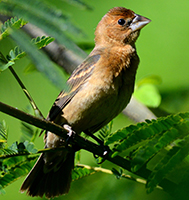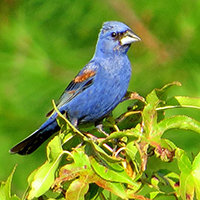Wildlife - Species
Blue Grosbeak (Passerina caerulea)

Photo by Dan Garber

Photo by Lee Weber
Description
The Blue grosbeak is a large bunting in the same family as the Northern cardinal, males measuring 7 1/2 inches in length. Coloration is a deep blue with black wing feathers with 2 wing bars- a wider upper bar of deep brown, and a lower and narrower wing bar of lighter brown. The female is smaller, about 6 inches in total length, brown in color with 2 buff colored wing bars and occasional blue feathers on the back and rump. Both sexes have the characteristic thick bill exhibited by buntings.
Voice
Only male Blue grosebeaks sing, in a long series of rapid warbles rising and falling in pitch. See Bird-Sounds.net for recordings of 602 species of bird calls in the U.S. and Canada. There are also a number of apps available that will identify bird sounds.
Habitat and Food
Brushy areas, streamside thickets, a mixture of native grasses, annual weeds and shrubs with an open canopy of taller trees. Also will use old, overgrown fields, powerline rights-of-way, and timber clearcut areas with some regrowth. Blue grosebeaks subsist on insects, snails, spiders, and seeds of primarily grasses.
Nesting
Blue grosebeaks breed in most southeastern states including South Carolina (they winter in Mexico and Central America to Cuba). Nests are typically built in low shrubs or small trees. Nests have been observed to contain pieces of snake skins, and males are known to participate in nest building along with the female. Two broods of 3-5 eggs each are generally raised by a single pair during the breeding season.
Additional Information
Amy Tegeler – Bird Conservation Coordinator
SCDNR
P.O. Box 23205
Columbia, SC 29224
Phone: (803) 521-2119
E-mail: TegelerA@dnr.sc.gov
